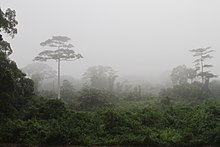Wildlife of Ivory Coast


The wildlife of Ivory Coast consists of the flora and fauna of this nation in West Africa. The country has a long Atlantic coastline on the Gulf of Guinea and a range of habitat types. Once covered in tropical rainforest, much of this habitat has been cleared, the remaining terrain being gallery forests and savanna with scattered groups of trees, resulting in a decrease in biodiversity. As of 2016, 252 species of mammal had been recorded in Ivory Coast, 666 species of bird, 153 species of reptile, 80 species of amphibian, 671 species of fish and 3660 species of vascular plant.
Geography

Ivory Coast is a country in western sub-Saharan Africa just north of the equator, bordered by Liberia and Guinea to the west, Mali and Burkina Faso to the north and Ghana to the east. To the south lies the Gulf of Guinea with a 515 km (320 mi) coastline where there is a network of lagoons. The land rises from south to north, the terrain being mostly flat to undulating plain, with mountains in the west and northwest. The highest point is Mount Richard-Molard on the border with Guinea, reaching 1,752 metres (5,748 ft). The main rivers flow from north to south. A dam on the Bandama River, the longest waterway in the country, has created the artificial Lake Kossou, while another on the Sassandra River has created the rather smaller Lake Buyo.[1]
The forests on mountains in the west of the country near the border with Guinea and Liberia, are classified as
Flora

As of 2016, 3660 species of vascular plant had been recorded in Ivory Coast.[4] The Ébrié Lagoon is dominated by mangroves and herbaceous vegetation including both rooted and floating aquatic plants. Further inland are extensive swamps with larger herbaceous plants and small trees.[5]
In the southwest of the country, the
Fauna
As of 2016, some 252 species of
Population growth and civil wars, together with deforestation, the increase area of plantations, hunting for bushmeat and other factors have led to a reduction in diversity among the animals in Ivory Coast,
Among the 670 species of bird that have been recorded in the country are 10 species of seabird and 119 species of water bird, with the remaining birds being terrestrial. There are no species
References
- ISBN 0-540-05831-9.
- ^ "The Republic of Côte d'Ivoire". West Africa: Land Use and Land Cover Dynamics. USGS. Retrieved 11 June 2019.
- ^ Robert E. Handloff, ed. (1988). "Ivory Coast: Climate". Library of Congress. Retrieved 12 June 2019.
- ^ a b "Countries with the most number of mammal species". Tropical Rainforests. Mongabey. 2016. Retrieved 16 June 2019.
- ^ ISBN 978-2-88032-949-5.
- ^ "Protection of a chimpanzee community in the Taï National Park through local community ecotourism". Fondation Ensemble. 2014. Retrieved 12 June 2019.
- ^ "Case Study: Protecting the ecological integrity of Comoé National Park". West Africa: Land Use and Land Cover Dynamics. USGS. Retrieved 12 June 2019.
- ^ "Case Study: Marahoué National Park: a protected area on the edge of existence". West Africa: Land Use and Land Cover Dynamics. USGS. Retrieved 15 June 2019.
- ^ McGinley, Mark. "Comoé National Park, Côte d'Ivoire". Encyclopedia of Earth. United Nations Environment Programme-World Conservation. Retrieved 15 June 2019.
- ^ "Taï National Park". UNESCO. Retrieved 15 June 2019.
- ^ "Parc National de Taï". Encyclopaedia Britannica. Retrieved 15 June 2019.
- ^ "Côte d'Ivoire". Data Zone. BirdLife International. Retrieved 15 June 2019.
- ^ "Côte d'Ivoire". Data Zone. BirdLife International. Retrieved 15 June 2019.

